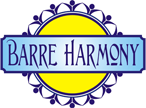So really, can the $20 to $30 spent on each class truly help lift your rear, tone your thighs, improve posture, and deliver a dancer’s body? Here’s what the experts say:
1. Those tiny movements can help you get stronger.
The isometric contractions that make up the bulk of a barre class occur when the muscle tenses without changing length. Think of these movements as the opposite of typical strength training moves (or concentric and eccentric contractions), which occur when a muscle stretches then shortens (as in a biceps curl). Isometric exercise is a great way to maintain muscle strength.
Photo: The Bar Method
“What’s wonderful about the one-inch movements is that you can hold a posture and benefit from continuously engaging the muscle, but you also get a mini-recovery with each pulse, so you can stay in the hold longer,” says Sadie Lincoln, fitness expert and founder of Barre3.
Bushong agrees that there’s a physical payoff from these tiny pulses. “Isometric movements help isolate specific muscles,” she says. “You can do more reps with smaller movements like these, which fatigue your muscles in a different way.” These higher-rep, low-weight exercises target slow-twitch muscles, which help increase endurance. In contrast, larger, compound movements target fast-twitch muscles, which help with power and speed (think running a marathon vs. sprinting). Plus, isometric movements can help strengthen muscles without straining tendons or ligaments, so there’s less risk of injury compared to more traditional strength training.
2. You’ll target multiple muscle groups at once.
“It’s a highly efficient workout since you’re doing two to four movements—holding, pulsing, stretching, for example—at a time in each move,” Leonard says. For example, in Bar Method classes, you’ll practice the “diamond waterski.” While holding onto the bar with one hand, your legs are in a diamond-shape, heels raised, while the torso is angled (think of a water-skier leaning back). This move mainly targets your quads, but at the same time you’re also challenging the calves, hamstrings, glutes, abs, and upper-back muscles. Bonus: “Working all these areas at once also helps raise the heart rate,” Leonard says.
3. You’re going to see your body shake like a bowl of JELL-O.
“This happens most commonly in thigh work at the barre, as you’re spending an extended period of time in a muscle (quad) contraction, while performing an isometric hold to intensify the work,” says Kira Stokes, trainer and creator of the Stoked Series and StokedC3BarreMAX. Shaking is a sign of muscle fatigue—your muscles are telling you they are feeling it. If taught and done correctly, this is a good thing. You may be tempted to pop out of the hold if you start to shake, but try to embrace the shake! “Also, if you worked your lower body the day before or you’re dehydrated, this can increase the likelihood of muscles trembling,” Stokes adds.
4. You’ll improve your mind-body connection.
The smaller movements in a barre class can bring a new level of awareness to the body that you don’t get in regular strength workouts, says Greatist Expert Jessi Kneeland, founder of Remodel Fitness. “In this way, barre can improve muscular activation for frequently underused muscles by strengthening the neuro-muscular (mind-body) connection,” she says.
5. You may lose weight.
“We’ve had students who have lost 100 pounds or more doing The Bar Method, but it’s so individual,” Leonard says. “You just have to be aware of your body and figure out what’s best for you to lose weight.” And it’s important to remember that what you eat can have a bigger impact on weight loss than what you do: “Ninety percent of losing weight is about what you eat and how much you eat,” Leonard says. (Hint: as little sugar as possible.)
Plus, as with any exercise, barre affects different body types in different ways. “While a trained ballerina or 6’2” model can come in and see results in a few classes, someone struggling with their weight may not see change as quickly,” Stokes says.
Depending on your body type and fitness level, you’ll see and feel changes in three weeks to three months, Leonard says—though making a major change in your body and losing a significant amount of weight could take more than a year. All that hard work will pay off, though: “Our students develop a natural youthfulness, power, and grace, and wonderful, natural posture and a lifted derriere,” Leonard says.

